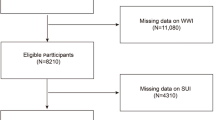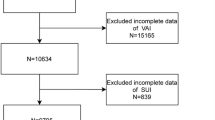Abstract
This study investigated the relationship between abdominal obesity and stress urinary incontinence in Korean women. Women aged 30 and over, who visited the Department of Family Medicine of Asan Medical Center were recruited to participate in this study. Anthropometric measurements including body mass index (BMI) and waist circumference were taken, and associated factors of stress urinary incontinence was assessed by questionnaire. Stress urinary incontinence was significantly associated with physical work, vaginal delivery, and high waist circumference. In comparison with women in the lowest quartile of waist circumference, the odds ratios (OR) for stress urinary incontinence in women in the second, third, and fourth quartiles were increased significantly (1.79, 95% CI 1.07–2.98; 3.50, 95% CI 2.02–6.07; and 6.07, 95% CI 3.23–11.40, respectively). Our results indicate that high waist circumference may be a risk factor associated with stress urinary incontinence in women.
Similar content being viewed by others
References
Hunskaar S, Arnold EP, Burgio K, Diokno AC, Herzog AR, Mallett VT (2000) Epidemiology and natural history of urinary incontinence. Int Urogynecol J 11:301–319
Abrams P, Cardozo L, Khoury S, Wein A (eds) (2002) Incontinence. In: Proceedings of the second international consultation on incontinence, 2nd edn. Health Publication Ltd., Plymouth
Hannestad YS, Rortveit G, Hunskaar S (2002) Help-seeking and associated factors in female urinary incontinence. The Norwegian EPINCONT study. Epidemiology of incontinence in the county of nord-trondelag. Scand J Prim Health Care 20:102–107
Seim A, Silvertsen B, Eriksen BC, Hunskaar S (1996) Treatment of urinary incontinence in general practice: observational study. BMJ 312:1459–1462
Rortveit G, Hannestad YS, Daltveit AK, Hunskaar S (2001) Age- and type-dependent effects of parity on urinary incontinence: the Norwegian EPINCONT study. Obstet Gynecol 98:1004–1010
Thom DH, van den Eeden SK, Brown JS (1997) Evaluation of parturition and other reproductive variables as risk factors for urinary incontinence in later life. Obstet Gynecol 90:983–989
Parazzini F, Chiaffarino F, Lavezzari M, Giambanco V (2003) VIVA study group. Risk factors for stress, urge or mixed urinary incontinence in Italy. Br J Obstet Gynaecol 110:927–933
Yarnell JW, Voyle GJ, Sweetnam PM, Milbank J, Richards CJ, Stephenson TP (1982) Factors associated with urinary incontinence in women. J Epidemiol Community Health 36:58–63
Cummings JM, Rodning CB (2000) Urinary stress incontinence among obese women:review of pathophysiology therapy. Int Urogynecol J 11:41–44
WHO (1998) Obesity: preventing and managing the global epidemic. World Health Organization, Geneva
Yarnell JW, Voyle GJ, Richards CJ, Stephenson TP (1981) The prevalence and severity of urinary incontinence in women. J Epidemiol Community Health 35:71–74
Mommsen S, Foldspang A (1994) Body mass index and adult female urinary incontinence. World J Urol 12:319–322
Yarnell JW, Voyle GJ, Sweetnam PM, Milbank J, Richards CJ, Stephenson TP (1982) Factors associated with urinary incontinence in women. J Epidemiol Community Health 36:58–63
Gregory SP (1994) Developments in the understanding of the pathophysiology of urethral sphincter mechanism in competence in the bitch. Br Vet J 150:135–150
Janssens LA, Peeters S (1997) Comparisons between stress incontinence in women and sphincter mechanism incompetence in the female dog. Vet Rec 13:620–625
Nathan PA, Keniston RC, Myers LD, Meadows KD (1992) Obesity as a risk factor for slowing of sensory conduction of the median nerve in industry. A cross-sectional and longitudinal study involving 429 workers. J Occup Med 34:379–383
Heliovaara M (1987) Body height, obesity, and risk of herniated lumbar intervertebral disc. Spine 12:469–472
McKeigue PM, Shah B, Marmot MG (1991) Relation of central obesity and insulin resistance with high diabetes prevalence and cardiovascular risk in South Asians. Lancet 337:382–386
NIH (1998) Clinical guidelines on the identification, evaluation, and treatment of overweight and obesity in adults—the evidence report. National Institute of Health, Bethesda
Korean Ministry of Health and Welfare (2002) The Korean national health nutrition examination survey 2001. Korean Ministry of Health and Welfare, Seoul
Bray GA (1998) Contemporary diagnosis and management of obesity. Handbooks in Health Care Co., PA, pp 9–34
Tornaghi G, Raiteri R, Pozzato C, Rispoli A, Bramani M, Cipolat M, Craveri A (1994) Anthropometric or ultrasonic measurements in assessment of visceral fat? A comparative study. Int J Obes Relat Metab Disord 18:771–775
Subak LL, Johnson C, Whitcomb E, Boban D, Saxton J, Brown JS (2002) Does weight loss improve incontinence in moderately obese women? Int Urogynecol J Pelvic Floor Dysfunct 13:40–43
Deitel M, Stone E, Kassam HA, Wilk EJ, Sutherland DJ (1988) Gynecologic-obstetric changes after loss of massive excess weight following bariatric surgery. J Am Coll Nutr 7:147–153
Bump RC, Sugerman HJ, Fantl JA, McClish DK (1992) Obesity and lower urinary tract function in women: effect of surgically induced weight loss. Am J Obstet Gynecol 167:392–397
Sustersic O, Kralj B (1998) The influence of obesity, constitution and physical work on the phenomenon of urinary incontinence in women. Int Urogynecol J Pelvic Floor Dysfunct 9:140–144
Nygaard I, DeLancey JO, Arnsdorf L, Murphy E (1990) Exercise and incontinence. Obstet Gynecol 75:848–851
Simeonova Z, Bengtsson C (1990) Prevalence of urinary incontinence among women at a Swedish primary health care centre. Scand J Prim Health Care 8:203–206
Hannestad YS, Rortveit G, Daltveit AK, Hunskaar S (2003) Are smoking and other lifestyle factors associated with female urinary incontinence? The Norwegian EPINCONT study. Br J Obstet Gynaecol 110:247–254
Burgio KL, Matthews KA, Engel BT (1991) Prevalence, incidence and correlates of urinary incontinence in healthy, middle-aged women. J Urol 146:1255–1259
Hording U, Pedersen KH, Sidenius K, Hedegaard L (1986) Urinary incontinence in 45-year-old women. An epidemiological survey. Scand J Urol Nephrol 20:183–186
Brocklehurst JC (1993) Urinary incontinence in the community-analysis of a MORI poll. BMJ 306:832–834
Thom D (1998) Variation in estimates of urinary incontinence prevalence in the community: effects of differences in definition, population characteristics, and study type. J Am Geriatr Soc 46:473–480
Author information
Authors and Affiliations
Corresponding author
Rights and permissions
About this article
Cite this article
Han, M.O., Lee, N.Y. & Park, H.S. Abdominal obesity is associated with stress urinary incontinence in Korean women. Int Urogynecol J 17, 35–39 (2006). https://doi.org/10.1007/s00192-005-1356-8
Received:
Accepted:
Published:
Issue Date:
DOI: https://doi.org/10.1007/s00192-005-1356-8




